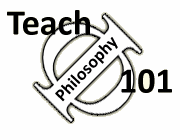Teach Philosophy 101
Free resources for
philosophy teachers!
"One of the most comprehensive, well-researched, and accessible guides for teachers that I have ever seen." James Lang, Chronicle of Higher Education (read full review of TΦ101)
Rubrics
A rubric is a way of assessing work that lists the criteria for evaluating a student's work (for papers this might be: organization, use of evidence, etc.) and also explains the differences in quality in each criterion (Andrache). Since most of our students have never read a philosophy paper before, let alone written one, it is hardly surprising that they don't know what makes a paper good or bad. They have never participated in philosophical discussions so they don't really know what constitutes useful participation. Creating rubric is a good way to help them understand what you are looking for before they start to write the paper. The rubric also saves enormous time in helping the professor explain to students why they got the grade they got. (In other words, this is finally a suggestion that can actually save time) The best way to understand the concept is to look at some samples:
-
A helpful website with sample rubrics and a link to a PowerPoint presentation on rubrics from Dannelle Stevens and Antonia Levy, who also do workshops on rubrics .
-
Generic paper rubric from Kelly Bender, "What Does the Letter Grade Mean?" Assessment Update. 16.6 (2006):11.
-
Maralee Harrell (Carnegie Mellon University) has a detailed rubric specifically for grading philosophy papers. "Grading According to a Rubric." Teaching Philosophy. 28.1 (2005): 3-14. (See the article itself for the entire rubric). Villanova has a more holistic rubric for papers in the sense that it doesn't assign numerical weights to each category.
-
Perhaps the most detailed rubric we have seen for grading philosophy papers comes from Micah T. Lewin (GSU Perimeter College).
-
Rubrics can also be used for grading class participation, projects, or any other assignment. Adam Chapnick has a helpful rubric for participation, for a more general discussion of grading class discussion (and a less detailed rubric) see this article by Martha L. Maznevski.
-
-
Villanova has blog instructions and rubrics. Villanova also has a rubric for oral presentations as part of our discussion of using class presentations as assignments.
One problem with rubrics that TΦ101 has encountered is that students often don't read or comprehend the rubric before writing the paper, so the greatest use of the rubric is to explain the evaluation of the paper after it is done. TΦ101 has been experimenting with a simpler self-evaluation checklist, which may be easier for students to work with.
Sources:
Heidi Goodrich Andrade, Teaching with Rubrics: The Good Bad and the Ugly, College Teaching, 53. (2005) 27-30.
Dannelle D. Stevens and Antonia J. Levi, Introduction To Rubrics: An Assessment Tool To Save Grading Time, Convey Effective Feedback and Promote Student Learning. Stylus Publishing (2004)
Author: John Immerwahr
Update: June 14, 2017 (E. Tarver)
